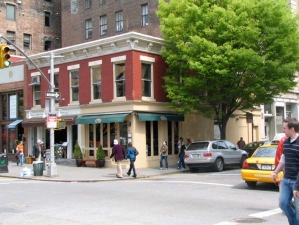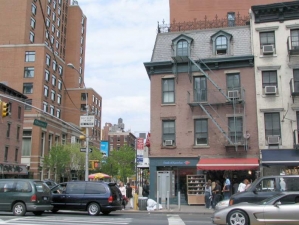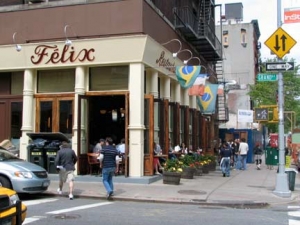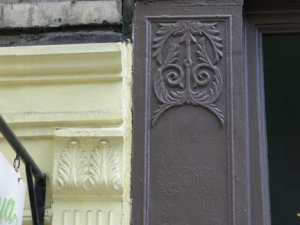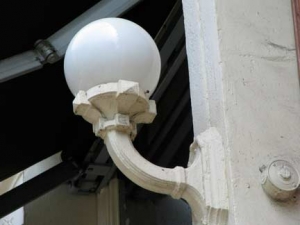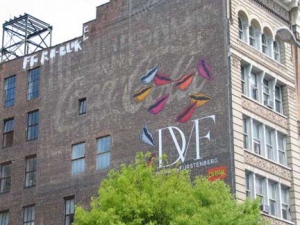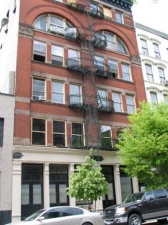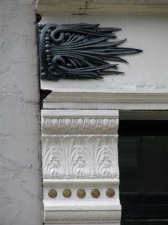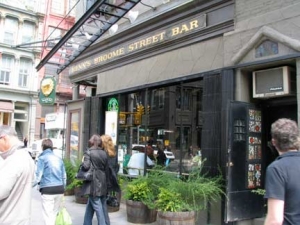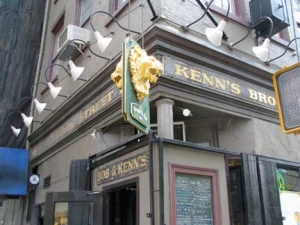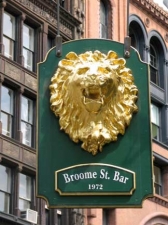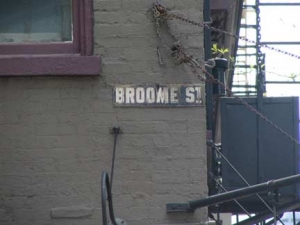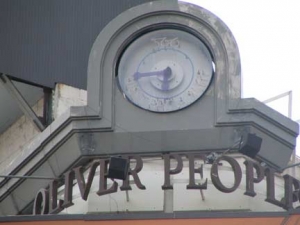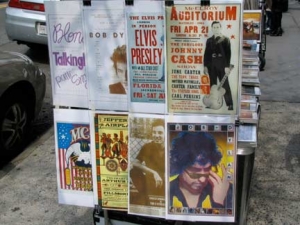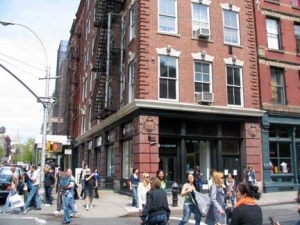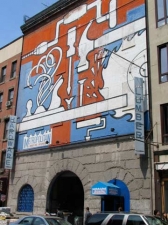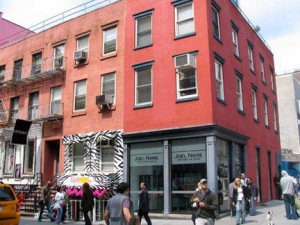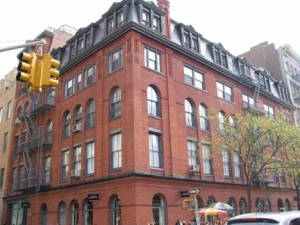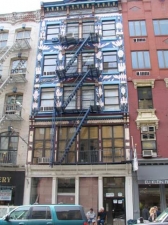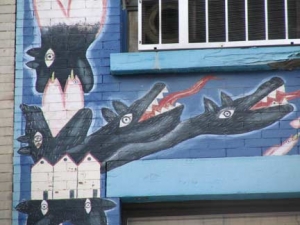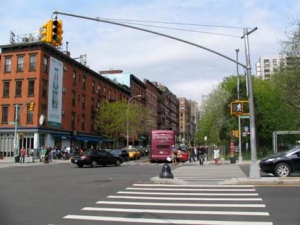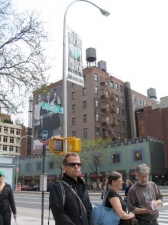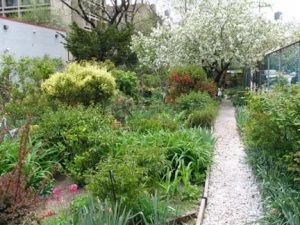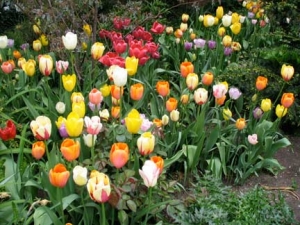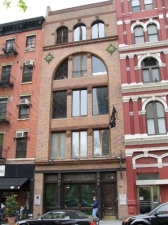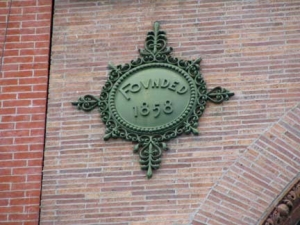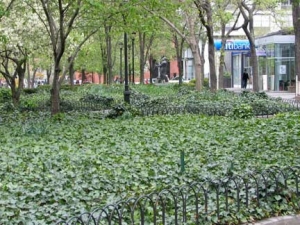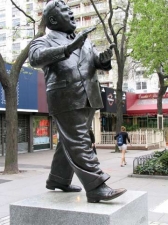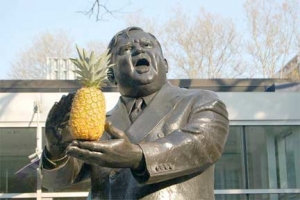Continued from West Broadway Part 2
West Broadway and Grand Street. Once north of Canal Street, West Broadway enters Soho (no longer below Canal but now south of Houston) and changes character completely, becoming the main shopping and restaurant strip in a neighborhood jampacked with them…
Prior to about 1840 the stretch of West Broadway between Canal Street and Washington Square Park was called Laurens Street.
Canal Street is now a pedal to the metal connector between the Manhattan Bridge and the Holland Tunnel, and along with Mott, Chinatown’s main shopping street; but it was once an actual canal. These used to be a freshwater pond called the Collect where Foley Square and all its state and city courthouses are today, and it remained fresh for hundreds of years in the pre-colonial period when the Lenape Indians were running the show. As soon as the Dutch and then the British arrived, the Collect filled with waste until the stench was unbearable. A canal was dug across the island to completely drain the Collect in the early 1810s, and the situation was
solved for a time until the canal itself was befouled; it was then placed underground, and Canal Street was built on top.
Above we see an 1820s or 1830s-era building, still with roof crenellation, at the NE corner of Canal and West Broadway. Some very old buildings can be found under the Canal Street signage. The Soho Grand (see below)
looms in the background.
Building detail at Ideya, and another good lamp next door.
Oh, the humanity! Diane Von Furtsenberg tags the Grand Street Coca-Cola painted ad!
This stretch of West Broadway is filled on weekends with sidewalk art dealers, and since your webmaster is furnishing an apartment, there was plenty to interest me, actually: old NYC prints, ads from the mid-18th century, and abstract art (yes I have a soft spot for it). I’ll certainly be returning, though on the day I shot these photos, I wasn’t feeling sufficiently flush…
Kenn’s Broome Street Bar, SE corner of West Broadway and Broome, is in one of the oldest buildings in the area, a Federal-style house going back to 1825; there has been a saloon in the building since the 1850s. It remaisn popular with truckers barreling down Broome Street to the Holland Tunnel. But, there are works from area artists who lived in the area hanging on the walls, from Willem De Kooning, Claes Oldenburg and Keith Haring.
The “Guggenheimer Ordinance” was passed by the Assembly in 1901, requiring corner property owners to place signs on their dwellings made of “five-inch porcelain letters set on a blue ground.”
Though the mandate was widely opposed, you can still see several signs around town fitting that description.
While the Ipod ad with the swingin’ chi…er, enthusiastic young woman is placed on the SW corner building to remind motorists of the device’s fun factor, I was attracted to the clock on the corner. It was likely installed by Oliver Peoples’ eyewear, but may be older and Peoples may have remodeled it.
Meanwhile the NE (left) and NW corners of Broome and West Broadway are formidable in their own rights.
At the northwest corner of Broome and West Broadway stands a building created by CITE Design several years ago. Three stories high, it mimics the round-shouldered window openings typical of early 1870s cast-iron buildings. But to Stephen Gottlieb, an architect and a board member of the Victorian Society, it is “clunky and dull,” and looks like a “Star Wars armor-plated walking gun.” Christopher Gray, New York Times
Some of the art I was mentioning earlier.
383 West Broadway, north of Broome. To me this has both religious and classical elements; she looks like she has a halo, while the curved elements on either side resemble snakes, like Medusa.
Above: happy spring crowd on Spring Street.
LEFT: I had never paid attention before to the great line drawing on the exterior at Metropolitan Hardware at 173 Spring. Even the presence of a lumberyard in Soho seems unusual, but I believe some dwellings in the area have wood burning fireplaces.
Prince Street, still not a bad building in sight (NW and SE corners) The zebra-striped entrance (153 Prince) belongs to Girl Props. The other building houses French Connection, which when it was touting a British affiliation was called FCUK (sigh). Media mogul Rupert Murdoch lives on the NE corner of West Broadway and
Prince.
460 West Broadway between Prince and East Houston. We’ve seen hardware line drawings and zebra stripes, but this bit of bizzarerie is vaguely obscene, but not quite; sea monsters, fish and cow udders?
Any ForgottenFans know the artist?
Ernest Aebi, the owner of 460 West Broadway, would probably not have gotten landmark approval for his three- story-high mural of black wolf heads devouring fleeing pigs in pink, black and blue, painted by the artist Friedrich Gross around 2001. Christopher Gray, New York Times
Home stretch: East and West Houston Street has undergone a thorough makeover since I walked it from river to river in 2005 (it is the southernmost street to do so, but Fulton Street will regain the title if it is reconstructed as palnned). It has gained a set of davit-style lampposts (straight masts with curves at the top).
For years the city has been monkeying with the name of West Broadway between Houston Street and Washington Square; it has, in various decades, been called South 5th Avenue (copying Manhattan’s other iconic north-south street wasn’t enough?) In 1967 the city settled on honoring Mayor Fiorello LaGuardia (1882-1945)
LaGuardia Place long had a wide, barren stretch on its east side. This was going to be a connection to 5th Avenue of the thankfully cancelled LoMex (Lower Manhattan Expressway). The space has since been filled by community gardens…
LaGuardia Corner Gardens, east side between East Houston and Bleecker Streets.
In 1981 a group of neighborhood gardeners, forced to relocate when displaced from their garden by development, received approval from Community Board 2 to create a garden on a neglected strip of land on LaGuardia Place.
In 1982, after a fence was completed, the gardeners divided the site into individual plots; sifted the soil, separating out the rubble; built a shed; and put in the first plants. In 1983 the boards separating the plots, the perimeter path, and the above-ground water system were completed. By 1985 the permanent water service was connected. LaGuardia Gardens
As mentioned earlier several NYC buildings have “Easter eggs” like faded ads or engraves dates. 508 West Broadway, opposite the gardens, is another one of those; note the two medallions above the 4th floor. But what was founded in 1858 that was housed in this 1891 building?
I spy someone I know across the ivy…Fiorello!
Neil Estern’s 1994 sculpture embodies the enthusiasm NYC’s 99th mayor, Fiorello LaGuardia, brought to City Hall for 12 years, 1933 to 1945.
Above photo: Paul Fugelsang
The end of West Broadway-College Place-Chapel Street-Laurens Street-South 5th Avenue-LaGuardia Place is at Washington Square Park, and I’ve had enough, how about you?
I thought so.


